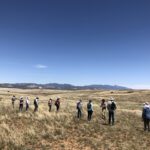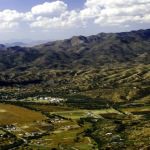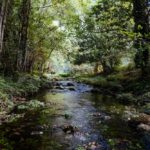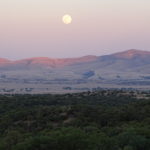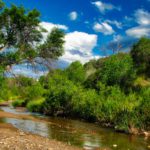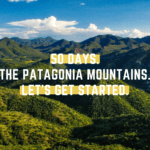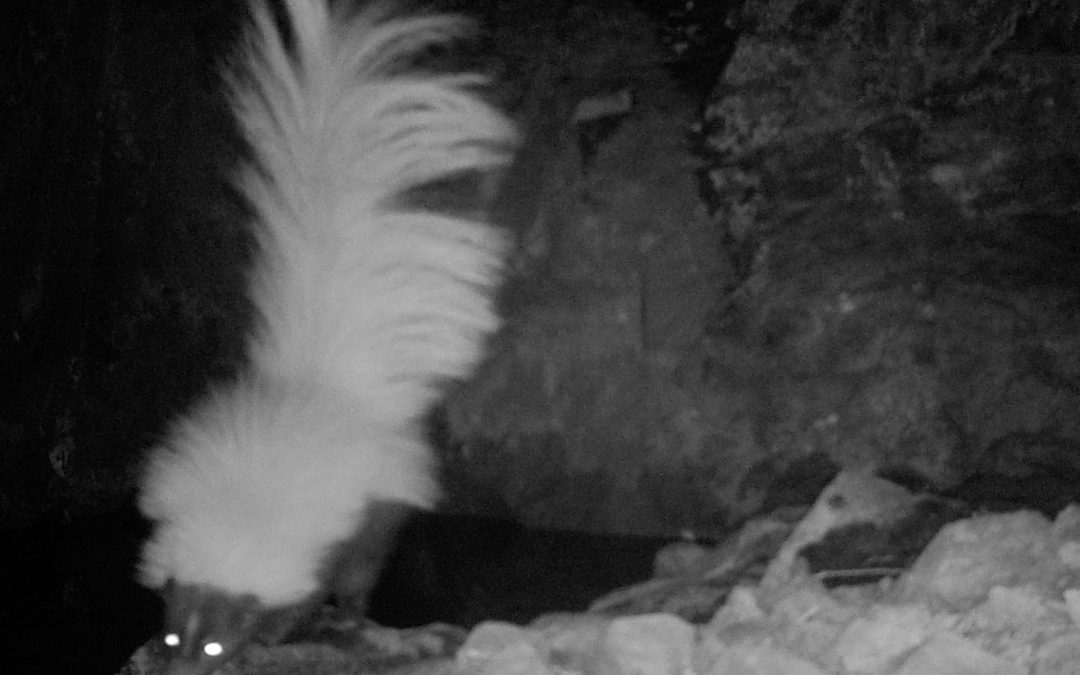
May 22, 2020 | Blog
Today, we’re excited to feature the hooded skunk (Mephitis macroura). This little creature has been captured on Sky Island Alliance cameras as part of the Border Wildlife Study and captured on Patagonia Area Resource Alliance (PARA) cameras on the west side of the Patagonia Mountains. Through this collaboration, we’re excited to observe how hooded skunks migrate between the U.S. and Mexico, seeking habitats that include lowlands, wooded mountains, and areas with streams and springs.
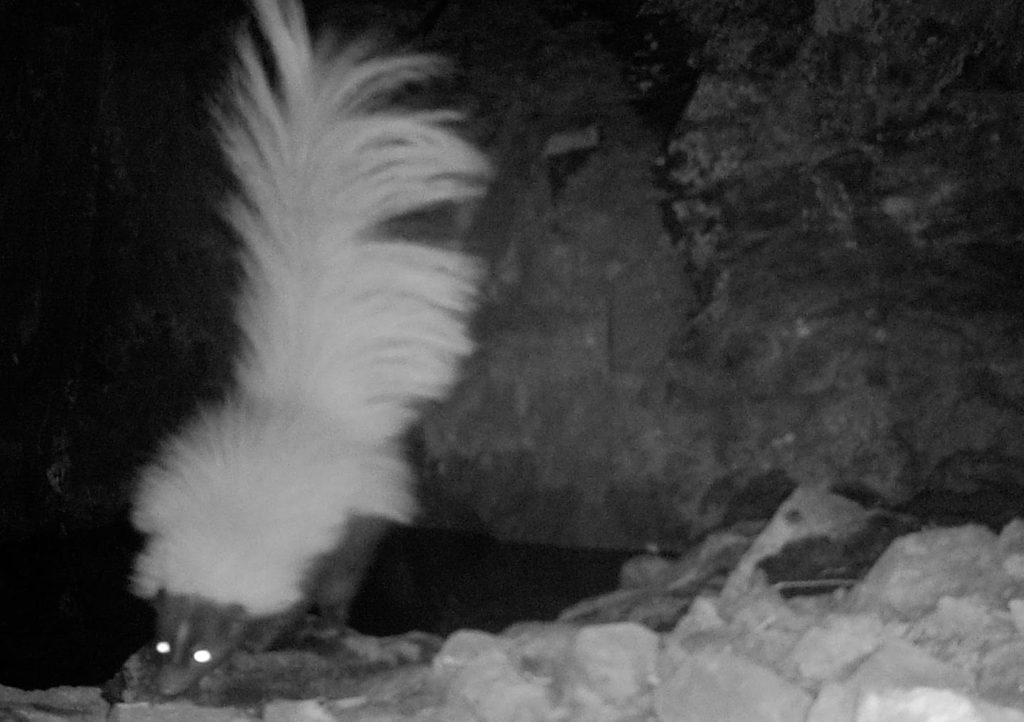
A hooded skunk found in the Patagonia Mountains. © Patagonia Area Resource Alliance
Here are some facts about hooded skunks to get you acquainted with their habits and habitats—all without having to get up close and personal!
1. The hooded skunk species is found throughout the American Southwest (Arizona, New Mexico, and Texas), Mexico, and Central America.

Hooded Skunk Range. Source: The Animal Files
2. Within the Mephitis macroura species, there are four subspecies. Only one, the Mephitis macroura milleri, is found in the American Southwest and in northern Mexico.
3. When compared to the size of other skunk species, the hooded skunk falls right in the middle. It is smaller than striped skunks and larger than spotted skunks. (All three of these species have been caught on PARA and Sky Island Alliance cameras.)
4. Hooded skunks are easily identified by the long white hair that covers their bodies and necks. Their heads and sides are often black, however, giving them the appearance of wearing a hood. Their tails tend to be bushier than other skunk species with a feather-like appearance.
5. Hooded skunks build dens in habitats with rocks and plentiful vegetation. They like to live near a water source, such as a river, spring, or stream, and tend to prefer areas with lowlands, forests, or the high desert.
6. Mating season for hooded skunks typically falls between February and March. Females will carry their young, called kits, for two months before giving birth to a litter. Each litter contains three to eight offspring.
7. Hooded skunks live an average of three years, though they tend to live shorter in the wild due to predators.
8. Hooded skunks are nocturnal. They leave their dens near dusk and spend the night searching for food.
9. Like raccoons, hooded skunks have been known to seek out and eat human garbage. Mostly, though, their diet consists of insects, vertebrates, and a little bit of plant material (such as fruit).
10. Hooded skunks are threatened by humans (hunting, roadkill) more than any other predator. To protect themselves from predators, they will hide in the burrows or dens of other animals or take cover in cholla cacti. They can also spray in defense like other skunk species.
The hooded skunk species’ conservation status is listed as “Least Concern” on the IUCN Red List, and it’s believed their population is steadily increasing across the U.S., Mexico, and Central America.
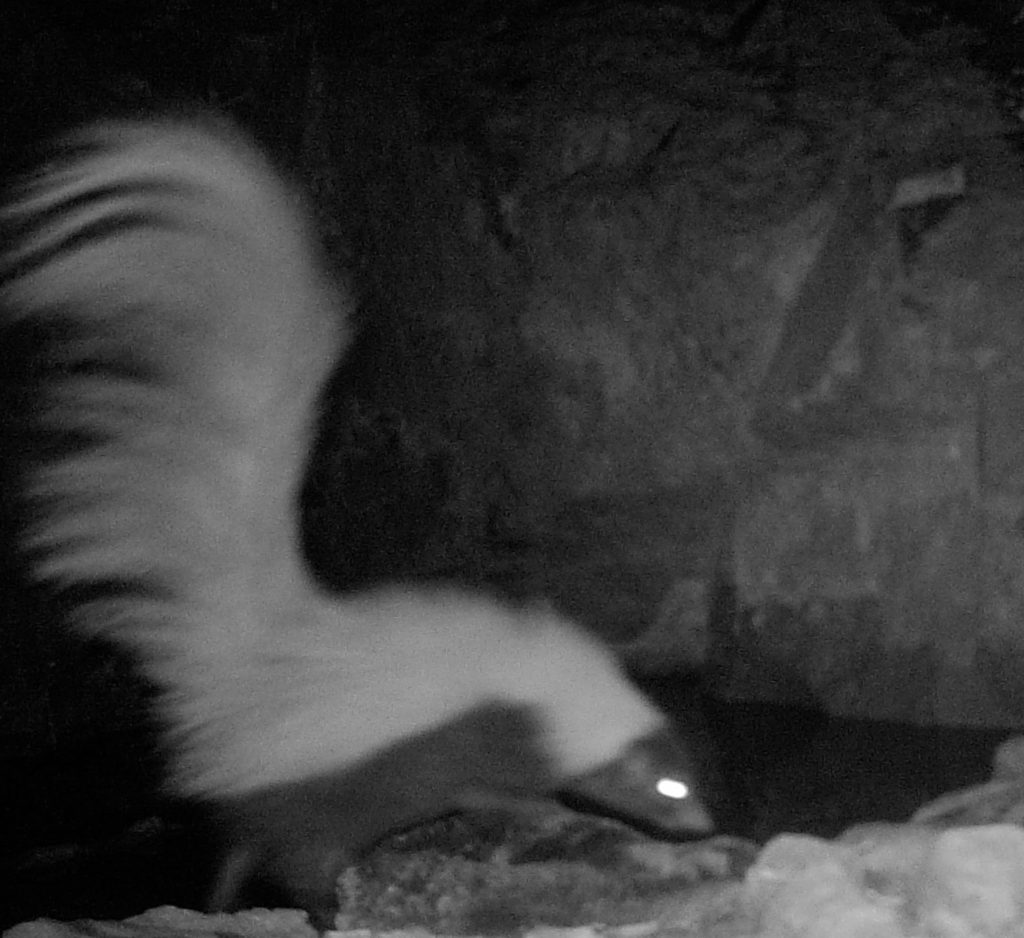
Hooded skunk. © Patagonia Area Resource Alliance
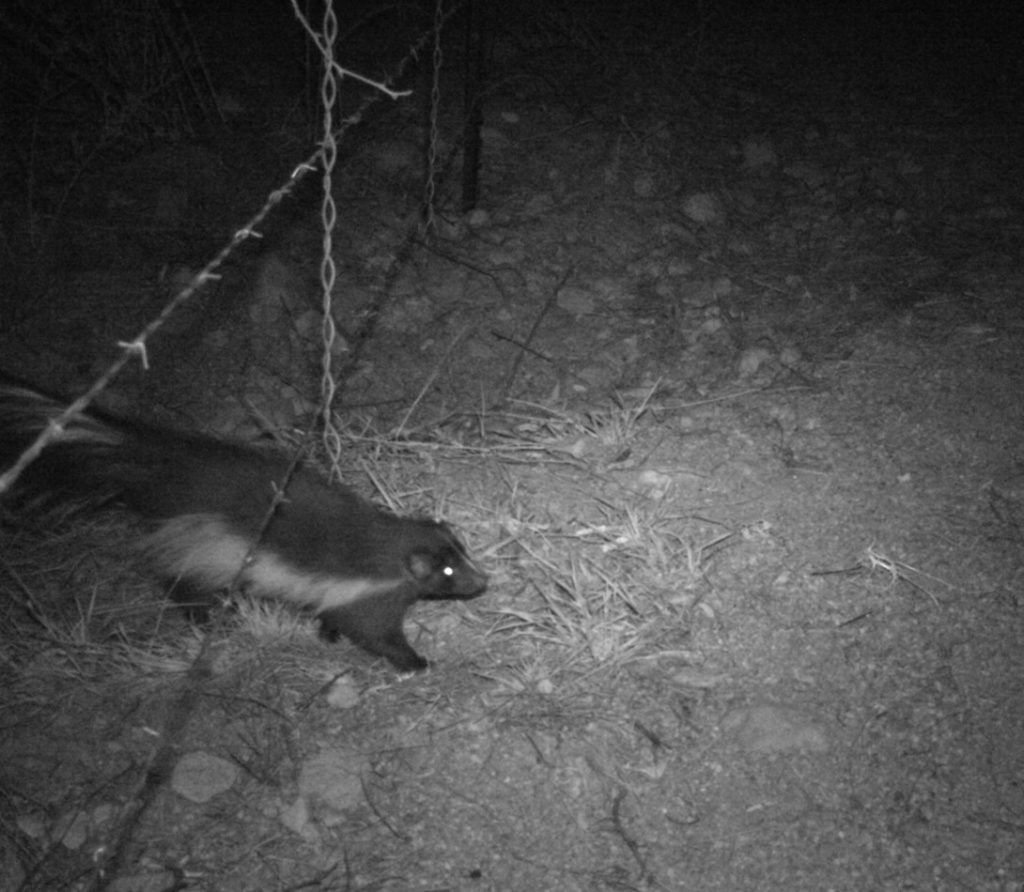
Hooded skunk with dark fur. © Sky Island Alliance
Similar Creature Features:
Western Spotted Skunk (Sky Island Alliance)
Hooded Skunk Sources:
Animal Diversity Web
PBS
Texas Tech University
The Animal Files
May 19, 2017 | Press
POTENTIAL IMPACT OF MINING ON PATAGONIA AREA
Early in May, Arizona Mining Inc (AMI) released its Preliminary Economic Assessment (PEA). As a Canadian company trading on the Toronto Stock Exchange, AMI is guided by National Instrument 43-101 Standards of Disclosure for Mineral Projects which defines the information that can be provided in a PEA and “. . . it can only demonstrate the potential viability of mineral resources, not the technical or economic viability of a project.”
Some of the items in the PEA related to water, hazardous materials and truck traffic:
“For the PEA it was ASSUMED [emphasis added] an adequate water resource from ground water wells is available on the mine property.” p 201
The project will use 650 gallons of water per minute. If the mine goes into production, it will operate 24 hours, 7 days a week. 650 gallons of water per minute is 936,000 gallons per day, 6,552,000 gallons per week, 27,846,000 gallons per month, 334,152,000 gallons of water annually.
“After mineral extraction, approximately 50% of the tailings will be sent back underground as backfill . . .” p7
“The recommended mining method is sub-level open stoping.” p 8 “The underground mine is relatively deep and has a large mining footprint.” p 17 The average drill depth in 2016-17 was 4,094 feet and the average depth of the Taylor holes is 3,725 feet.
“Mining activities will be fully mechanized and large modern trackless mobile equipment will be employed throughout.” p 140
Of the many chemicals (reagents) to be used onsite, two are HIGHLY toxic: sodium cyanide and ammonium nitrate.There will be extensive blasting. “This would require approximately 143 Tons / month of explosive requiring 7 transport deliveries per month. Peak consumption is in Year 6 and the maximum quantity of explosives required is 2,460 tons per year, or 205 tons per month, requiring 10 transport deliveries per month.” p 165
Timothy McVeigh used 2 tons of ammonium nitrate when he blew up the Murrah Federal Building in Oklahoma. 240 tons of ammonium nitrate were stored at the West Fertilizer Company in Texas when an explosion in 2013 killed 15, injured 200 and damaged many buildings.
The estimates for monthly truck traffic (estimates are ONE WAY so double the number to get road traffic):
SUPPLY AND CONCENTRATE TRUCKS:
(assumption is each truck carries 40,000 pounds)
ammonium nitrate deliveries p 165 7-10 per month
sodium cyanide deliveries p 205 1-2 per month
other chemical deliveries p 205 40 per month
shipment of concentrates p182 & 183 1,946 per month
(assumption: zinc and lead concentrates are material that would be shipped if not shipped as concentrates than number would be larger)
Employees p148
- 264 employees per day; 7,920 per month
OR
- AMI suggests employees will be bused from Nogales, Sierra Vista and Tucson which would be 180 buses per month (assumption buses are full and carry 50 people)
The BIG truck traffic totals an estimated 3,996 trucks per month or 133 BIG trucks per day on Harshaw road any time of the day or night. PLUS 264 employees who will travel in buses or personal vehicles.
Truck Access Roads: “Three access routes to the mine property were reviewed. Each route is along existing improved and unimproved roadways. The preferred alternative is to upgrade the existing Harshaw road.” “These potential new improvements or any operating restrictions could arise through the necessary coordination with the town of Patagonia, and possibly others.” p 163
As stated twice in the PEA (p 15 and p 212): “The PEA is preliminary in nature. It includes inferred Mineral Resources that are considered too speculative geologically to have the economic considerations applied to them that would enable them to be categorized as Mineral Reserves. There is no certainty that the PEA will be realized.”
The potential impact on the quantity and quality of water, the blasting and the increase in traffic would be devastating on the quality of life in the Patagonia area. This is just the tip of the iceberg which would be a mine operation in the middle of the Patagonia mountains, one of the most beautiful and biologically diverse areas of the United States. The impact on the area’s water system, the loss of tree coverage and the increase in noise 24 hours a day among all other impacts would make life difficult for all residents of the Patagonia area.
####
The 239 page PEA link: https://www.arizonamining.com/_resources/technical-reports/Arizona-Mining-Technical-Report.pdf
Patagonia Area Resource Alliance is a grassroots, non-profit community alliance committed to preserving and protecting the Patagonia Mountains and to empowering people to steward this global biodiversity hotspot. Contact info@patagoniaalliance.org or Carolyn Shafer at 520.405.1117 |
|

Oct 6, 2016 | Blog
Imagine a little-known national treasure — a largely wild land home to ocelots, exotic and imperiled birds like elegant trogons and Mexican spotted owls, imperiled reptiles and amphibians like the threatened Chiricuahua leopard frog, and El Jefe, the only jaguar currently living in the United States. This is the Mountain Empire of southern Arizona, a place as special as Yosemite or Yellowstone, and worthy of international recognition. Extending across the border into northern Sonora, Mexico, this region is bounded by mountains that rise from the flat desert floor to touch the sky. With one of the richest concentrations of biodiversity in the U.S., the Mountain Empire is a sanctuary for imperiled species. But even a sanctuary can be threatened.

Mountain Empire, © Thunderforest
Refuges in the Sky
One reason the Mountain Empire has so many rare and unique species is the rugged sky island mountain ranges. Each range, like the iconic Santa Rita Mountains, south of Tucson, stands alone surrounded by desert flatlands like an island in the sea, with mountains so tall that they span climate zones from hot, dry desert to moist forests at higher altitudes. Together, these characteristics give the mountains their nicknames of “sky islands.” For many species, the sky islands are refuges where human impacts have been relatively small. Streams rise from the rocks, nurturing rare fish, frogs, snakes, and nesting habitat for birds like threatened yellow-billed cuckoos, southwestern willow fly catchers and hummingbirds.
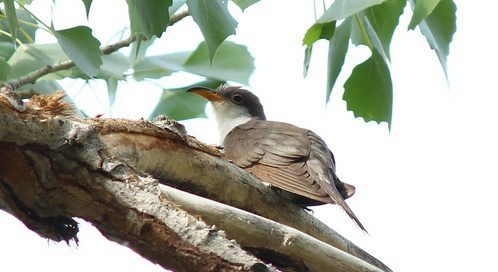
Western yellow-billed cuckoo, © Creed Clayton/USFWS
There are so many hummingbird species in the Mountain Empire that the Tucson Audubon Society founded the Paton Hummingbird Center, dedicated to conserving hummingbirds and other local biodiversity.
Birders visit from countries around the world for the chance to see so many species in one place. One of Defenders’ board members, Dr. Ron Pulliam, works with the Mountain Empire group Borderlands Restoration to restore the plants that hummingbirds, bees, butterflies, and moths need along Harshaw and Sonoita Creeks in the Patagonia Mountains. The globally imperiled Patagonia eyed silk moth, once widespread in native grasslands, is now making its last U.S. stand in the Patagonia Mountains. The threatened southwestern willow flycatcher, once common near Tucson in now-vanished gallery forest along the Santa Cruz River, is today found higher up in riparian vegetation along still-flowing mountain streams.
One of the gems of the Mountain Empire is the Las Cienegas National Conservation Area: 45,000 acres of rolling grasslands, oak-studded hills, along with the Cienegas Creek wetlands. This is home to the world’s largest population of endangered Gila topminnow and other federally threatened and endangered fish, frogs and snakes. Las Cienegas provides a vital corridor of protected lands that connects the Santa Rita and Whetstone sky islands.
The most revered animal in the Mountain Empire is El Jefe, a powerful male jaguar. Video of him prowling along a stream in the Santa Rita Mountains recently went viral, with at least 20 million viewers. He and other jaguars and ocelots most likely came north to the U.S. from Sonora, Mexico in the past decade, travelling along sky island mountain corridors with little human activity.
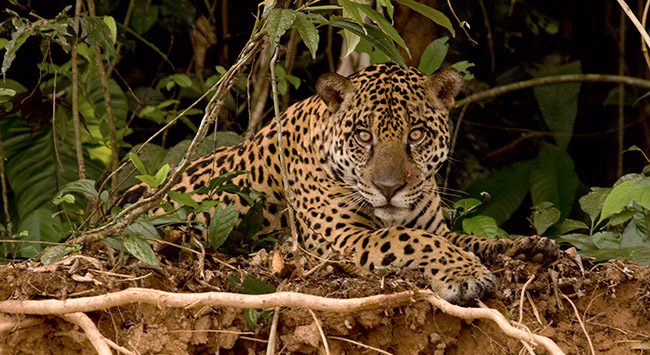
Jaguar, © Barry Draper
Threats to the Empire
Sadly, as much healthy habitat as there is in this region, there’s also a problem: Industrial mining. The Mountain Empire is riddled with old abandoned mines and grandiose plans for new ones. As you can imagine, mining has a massive impact on an ecosystem, from the land itself, to the noise that can scare wildlife away, to the traffic that would come in and out of the mining project. And perhaps most importantly, there’s the water.
Throughout the Southwest, so much groundwater has been pumped for agriculture, industry, and towns and cities that water tables have dropped and streams and ponds have dried up, desiccating wildlife habitat in a land already parched. This is why so many water-dependent species have vanished, or are threatened or endangered. In Arizona, 20 of 35 surviving native fish species are endangered and one is already extinct. Mining presents yet another threat to the water supply, using up billions of gallons of groundwater over the course of years, and often contaminating it with pollutants.
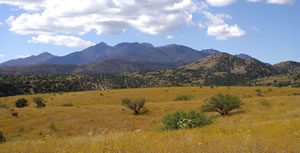
Santa Rita Mts, © Larry Jones/USFS
The diversity of the “sacred” Santa Rita Mountains in the Coronado National Forest is threatened by mining interests.
The giant open-pit Rosemont Mine is planned for the Mountain Empire’s Santa Rita Mountains, where it would destroy habitat that is home to El Jefe and endangered ocelots. It would also decrease the water for the topminnow and other species in the Las Cienegas wetlands.
Two other mines are planned for the Patagonia Mountains in the center of the Mountain Empire. A Canadian company (ironically called Arizona Mining) is planning the Hermosa mine, which means beautiful in Spanish. There is nothing beautiful about this proposed silver mine: If done by the most economical open-pit method, it would gash a huge 4,000 foot wide hole in the mountains and dump the waste rock on the ground. A recent study by Earthworks and the Patagonia Area Resource Alliance estimated that an open-pit mine here would take as much as 1.2 billion gallons of water per year from nearby streams and wells, harming wildlife as well as the local economy, which is based largely on ranching and tourism. Exploratory drilling (to prove the minerals are worth mining) is already taking place right next to Harshaw Creek, up against the protected activity center for a pair of threatened Mexican spotted owls and habitat for threatened yellow-billed cuckoos.
Thankfully, none of these projects are going unchallenged. Defenders and the Patagonia Area Resource Alliance (PARA) are currently reviewing and preparing formal federal comments on a proposal by Arizona Mining to expand exploratory drilling onto Forest Service land. Last year, Defenders and PARA also joined in a lawsuit that overturned the Forest Service’s illegal approval of plans by another mining company, Regal Resources, to drill exploration cores along Harshaw Creek.
The Mountain Empire is an irreplaceable landscape in the Southwest. Defenders will keep working with local activists to monitor toxic spills and stop illegal mining that would harm the jaguars, ocelots, and other rare species that make it their home.
 Rob Peters, Senior Representative, Southwest Office
Rob Peters, Senior Representative, Southwest Office
As a jack-of-all trades in the Tucson Office, Rob collaborates with the Defenders Renewable Energy Group, helping evaluate and influence renewable energy policies and projects to ensure that renewable energy is developed wisely, with minimum harm to natural ecosystems. He also works on jaguar issues, helping plan for the eventual return of a viable population in the U.S., and he is the lead on Defenders efforts to safeguard Arizona’s Mountain Empire, a Defenders’ priority area surrounding the town of Patagonia. This area contains some of the last best native grasslands in the Southwest, along with important habitat for jaguar, Mexican spotted owl, and other endangered species.

Jul 31, 2015 | Blog
AZ Mining Inc / Wildcat Silver to Purchase Historic Trench Mine
|
|
|
| Wildcat Silver, now known as AZ Mining Inc, recently announced plans to purchase the 300 acre historic Trench Camp Mine from Asarco Multi-State Environmental Custodial Trust. The custodial trust was formed as a result of a bankruptcy settlement with ASARCO and tasked with cleanup of the abandoned mine.
Mining stopped at the underground Trench mine over 50 years ago, which is located in the Patagonia Mountains adjacent to AZ Mining’s existing 154 acres of private land inholdings. The purchase “will greatly enhance AZ Mining’s surface lands for any future mining operations,” according to a press release.
The press release also stated that AZ Mining Inc “has submitted a remediation work plan that addresses the environmental liabilities with the Arizona Department of Environmental Quality [ADEQ] and will construct a passive water treatment system estimated to cost US$2.6 million, excluding contingency, of which the Company’s share will be US$1.6 million.”
This would be the third time in recent history that the Trench Mine has undergone remediation work. The mine was “largely remediated by ASARCO” in the 1980’s and 1990’s, according to an ADEQ report.
More recent work was necessary after the Trench tailings pile dam overflowed with acidic water loaded with toxic heavy metals when heavy rains hit the Patagonia Mountains in September 2014. ADEQ issued six violations of state water-quality rules as a result of that spill.
AZ Mining Inc takes on these environmental issues with the purchase of the Trench mine. Wendy Russell, PARA Coordinator, told the Weekly Bulletin that she is doubtful the situation will be improved. “I’m really concerned about the environmental issues that we have with the Trench Mine, and if they’ll actually clean it up,” she said.

Highly toxic, acidic orange water overflowing from Trench Mine tailings in September 2014. |
| We have reasons to further question their incentives for this pending purchase. A look at the history of AZ Mining’s CEO and Board Chairman, Richard Warke, reveals questionable business practices as outlined in the documentary, Cyanide Beach, by investigative journalist John Dougherty.
Between 2003 and 2007, Warke was on the Board of Directors of Sargold Resource Corporation. Sargold owned and operated an open-pit gold mine near the small farming village of Furtei in south-central Sardinia, Italy. Cyanide Beach reveals a troubling history of Sargold’s business practices that includes:
- Failure to provide accurate and timely information to shareholders.
- Failure to pay vendors.
- Misspending a Sardinian government loan.
- Evidence of a self-enrichment scheme to benefit its chairman.
- Evidence of insiders receiving excessive discounts on stock purchases.
- Issuing misleading press releases.
Sargold also made numerous promises of clean up of the mine site. They even tried to leverage clean up plans for the acquisition of additional mining rights elsewhere. The clean up was never completed and the only mining that happened was re-mining the old tailings piles at the gold mine.
One day, workers discovered that the mining company had just walked away from the mine, leaving behind an unfolding environmental disaster.
Extensive supporting documentation for Cyanide Beach, including a timeline of the business history of Richard Warke, supported by thousands of pages of corporate disclosures, is posted at investigative journalist John Dougherty’s website: InvestigativeMedia.com.
This disastrous pattern of irresponsible behavior and the pending purchase of the Trench mine in the Patagonia Mountains further compels us in our on-going mission to keep our citizen watchdog eyes wide open and to pro-actively engage in protecting our water, area wildlife, and the well-being of the Patagonia area community. |
|
Thank You PARA Supporters!
We are very fortunate to have a group of amazingly committed community members and generous donors supporting our work. PARA’s efforts to protect and preserve the Patagonia Mountains and our community’s drinking water are only possible because of your financial support.
Consider making an automatic, monthly donation to the Patagonia Area Resource Alliance on your credit card through PayPal.
Every single contribution makes a sizable difference to our organization and ultimately for our community. It is only because of the generous support from people like you that we can undertake this critical work. Thank you! |
|
|
|

Apr 27, 2015 | Blog
New Decision Memorandum Issued for Sunnyside Mineral Drilling Project in Patagonia Mountains
 The Forest Service sent out a notice on April 10th that a new Decision Memo has been issued for the Regal Resources Sunnyside project, an exploratory mineral drilling proposal in the Humboldt Canyon and Alum Gulch areas of the Patagonia Mountains on the Coronado National Forest.
The Forest Service sent out a notice on April 10th that a new Decision Memo has been issued for the Regal Resources Sunnyside project, an exploratory mineral drilling proposal in the Humboldt Canyon and Alum Gulch areas of the Patagonia Mountains on the Coronado National Forest.
The emailed notice from the Forest Service stated that exploratory drilling can start once “the operator provides a reclamation performance bond, incorporates the design features from the decision document, and the Plan of Operations is approved.”
The notice is misleading because it fails to mention two important facts.
No drilling can take place between March 1 to September 30 to avoid potential disturbance to the Mexican spotted owl and Yellow-billed cuckoo during their breeding season, as stated in the Decision Memo.
Additionally, PARA and Defenders of Wildlife are still in litigation against the Forest Service and US Fish and Wildlife Service for this unlawful approval of the Sunnyside Proposal. Read more…
The Sunnyside mineral drilling proposal is located approximately 7 miles south of the town of Patagonia. For more information concerning this decision, please contact Mindy Sue Vogel, Geologist, Coronado National Forest, 300 W. Congress Street, Tucson, AZ 85701, 520-388-8327, msvogel@fs.fed.us.
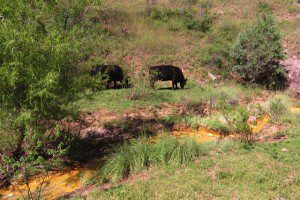
Feb 13, 2015 | Blog
FOR IMMEDIATE RELEASE
Regional Forester Issues Time Critical Removal Action Approval Memo
Patagonia, Arizona – Yesterday, the Southwestern Regional Office of the US Forest Service issued an Action Memo for “Time Critical” clean up of the abandoned Lead Queen mine in the Patagonia Mountains on the Coronado National Forest, approximately 6 miles south of the town of Patagonia, Arizona.
Members of the Patagonia Area Resource Alliance (PARA) discovered the abandoned mine over-flowing with toxic, orange sludge into a tributary of Harshaw Creek, last September. PARA documented the spill and notified authorities. The Harshaw Creek tributary eventually flows into the Town of Patagonia, Sonoita Creek and Patagonia Lake.
As the land owners of the Lead Queen mine, the Forest Service was issued two Notice of Violations from the Arizona Department of Environmental Quality: “Addition of a pollutant to navigable waters from a point source without a permit,” and “Discharge of storm water associated with an industrial activity without a permit.”
 Test results showed off-the-chart concentrations of lead and arsenic in water, soil and waste rock samples at the Lead Queen site. High concentrations of zinc, copper and aluminum were also found. All of these heavy metals are listed as “hazardous substances” and can cause serious – or even deadly – health issues. The red-orange color of the sludge was due to extreme concentrations of iron.
Test results showed off-the-chart concentrations of lead and arsenic in water, soil and waste rock samples at the Lead Queen site. High concentrations of zinc, copper and aluminum were also found. All of these heavy metals are listed as “hazardous substances” and can cause serious – or even deadly – health issues. The red-orange color of the sludge was due to extreme concentrations of iron.
The USFS document stated the clean up aims to reduce potential exposure of the hazardous heavy metals to “human populations, animals or the food chain.”
“This is a good start, but I’ve seen many more abandoned mines in the Patagonia Mountains that also need to be cleaned up. The mining industry has a well-earned reputation for just walking away from mines when they’re done.” Gooch Goodwin, native Patagonian and PARA board member.
 The Forest Service document also acknowledges that the “Patagonia Mountains have high levels of biodiversity and are home to a variety of species protected under the Endangered Species Act including jaguar, ocelot, lesser long-nosed bat, Mexican spotted owl, western yellow-billed cuckoo, Sonora tiger salamander, and the northern Mexican gartersnake.”
The Forest Service document also acknowledges that the “Patagonia Mountains have high levels of biodiversity and are home to a variety of species protected under the Endangered Species Act including jaguar, ocelot, lesser long-nosed bat, Mexican spotted owl, western yellow-billed cuckoo, Sonora tiger salamander, and the northern Mexican gartersnake.”
It additionally states, “the area is best-known and most popular places for birding in the U.S. Bird enthusiast who come from all over the world to catch a glimpse of more than 300 species of birds, including many Neotropical species that migrate, nest, and live in this unique habitat.”
Clean up of the five acre site is expected to start Spring 2015 and be completed before the coming monsoon season to avoid erosion and flushing of heavy metals further downstream.
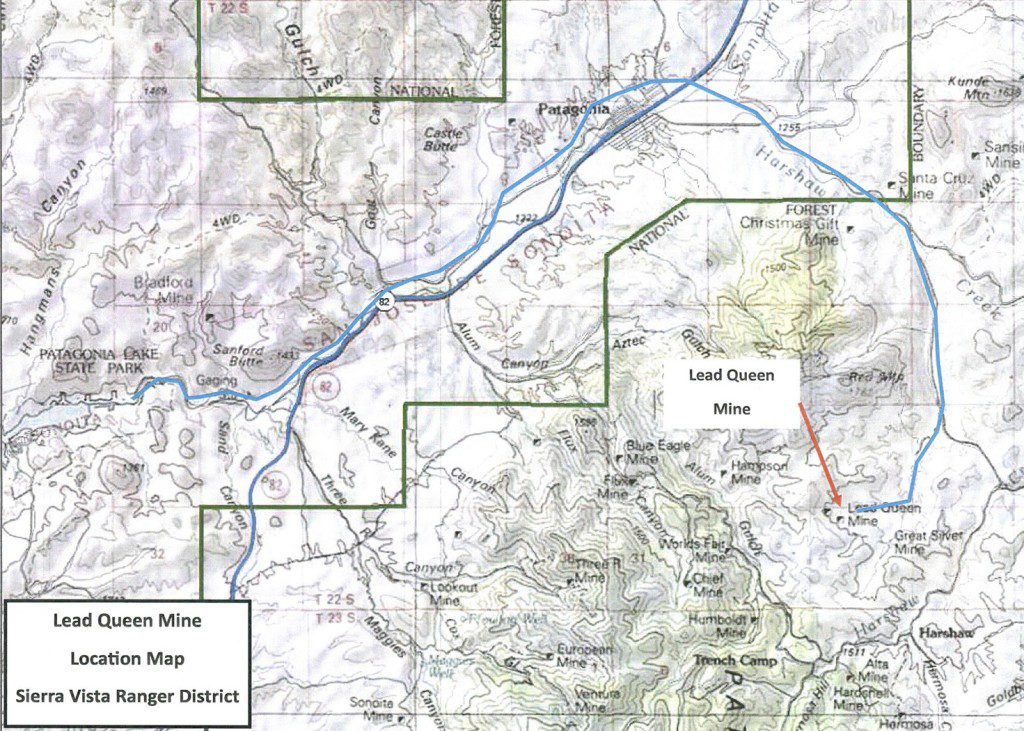
USFS map of Lead Queen mine location
Read USFS Lead Queen Mine Removal Action Memorandum
For further information regarding the USFS Removal Action Memorandum, please contact Eli Curiel, P.E., On-Scene Coordinator, at 520-388-8413; or Maria McGaha, P.E., Regional Environmental Engineer, at 505-842-3837.
###
The Patagonia Area Resource Alliance is a citizen watchdog organization that monitors the activities of mining companies, as well as ensures government agencies’ due diligence, to make sure their actions have long-term, sustainable benefits to our public lands, our water, and the town of Patagonia. For more information visit www.patagoniaalliance.org and follow us on Twitter @PARAalliance.

Nov 26, 2014 | Blog
It’s hard to believe that the end of the year is nearly upon us! When 2014 began, your friends, neighbors and colleagues here at the Patagonia Area Resource Alliance (PARA) were gearing up for a busy year promoting the incredible beauty, community, and natural heritage of the Town of Patagonia and the Patagonia Mountains. Little did we know what a whirlwind year it would be! The past eleven months have seemingly sped by while we have been advocating to protect this amazing place that we all treasure from the multiple threats that exploratory drilling and mining pose to our small community.
PARA was formed in 2011 to educate and engage the community about the risks and realities of mining, to promote local sustainable economies, to better understand our precious and imperiled natural resources such as clean water and wildlife, and to actively advocate for the protection of those resources in concert with Patagonia’s distinct and serene rural way of life.
You have helped us along the way this year! You have volunteered, come to public meetings, wrote letters, monitored wildlife, and participated in the NEPA process. Together, we have contributed over 2500 volunteer hours already in 2014!
It has been another amazing and transforming year for PARA, but we have so much more to do! PARA runs on a shoestring budget with the human power of an almost entirely volunteer workforce and our two person outreach team–budgeted for only 30 hours per week. We’d like to do so much more! Please consider making a donation to PARA this year to support and grow this critical work in our community.
A few of the activities and accomplishments reached this year through the contributions of all of PARA’s supporters, volunteers and partners:

Ocelot, Leopardus pardalis. photo US FWS
Holding Agencies Accountable
Filed a complaint in federal court in October with Defenders of Wildlife against the Forest Service and the Fish and Wildlife Service for their unlawful approval of the Regal Resources Sunnyside mineral drilling project in southern Arizona’s Coronado National Forest, in the Alum Gulch area of the Patagonia Mountains. The Sunnyside project approval violates environmental laws and poses a potential threat to endangered species and the safety of drinking water for Patagonia area residents. The Coronado National Forest, Patagonia Mountains and waterways in our region support some of the world’s most imperiled wildlife, including jaguar, ocelot, lesser long-nosed bat, Mexican spotted owl, and yellow-billed cuckoo.
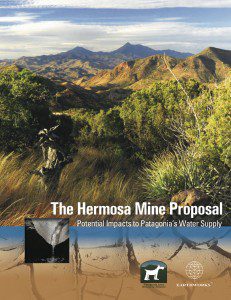 Educating the Community on Mining Risks
Educating the Community on Mining Risks
Released a peer-reviewed report with the national organization EARTHWORKS, “The Hermosa Mine: Potential Impacts to Patagonia’s Water Supply.” The report uses geologic and hydrologic studies from mine developer AZ Mining Inc (Wildcat Silver), the United States Geologic Survey, the Arizona Department of Water Resources, the Town of Patagonia, and others, as well as analyzes historic contamination issues caused by mining in the Patagonia Mountains. We conclude in our report that the seemingly inescapable realities of acid drainage and water consumption impacts pose too great a risk to Patagonia.
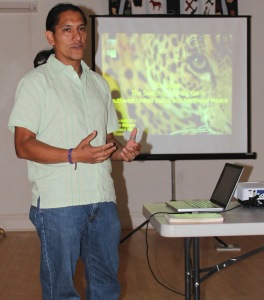
SIA Biologist, Sergio Avila
Empowering the Community, Ensuring Due Diligence
Coordinated and submitted NEPA comments on the USFS draft Environmental Assessment for the AZ Mining Inc (Wildcat Silver) Hermosa drilling project with Defenders of Wildlife, Arizona Mining Reform Coalition, Center for Biological Diversity, Earthworks, and Sky Island Alliance. Hosted a community workshop to empower residents to comment on the Hermosa EA comprising of an overview of the Hermosa proposal and its likely impacts; a NEPA presentation and how to comment on an EA by Jenny Neeley, Attorney at Law; and a presentation of area wildlife by Biologist, Sergio Avila, of Sky Island Alliance.
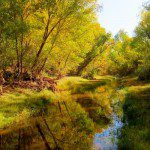
Sonoita Creek
Tireless Advocacy for Patagonia Area Water and Wildlife
Submitted comments regarding the proposed United States Forest Service Guidelines on Groundwater, advocating for groundwater protection and consideration of potential impacts regarding all agency activities in our National Forests, especially in regards to hardrock mining. Submitted comments to the Environmental Protection Agency regarding the proposed rule defining the “Waters of the U.S.” advocating for protection of ephemeral and intermittent streams. Submitted comments advocating for more designated critical habitat in the Patagonia Mountains for the threatened yellow-billed cuckoo.
To learn more about our 2014 accomplishments and efforts, please take a look at PARA’s “Report to the Community” available on our website at: www.patagoniaalliance.org/our-activities- outreach/
Looking Ahead…
Unceasing Protection of the Patagonia Mountains.
With continued legal assistance from Defenders of Wildlife, PARA strives to hold mining companies, the US Forest Service and all agencies accountable to follow the laws and regulations designed to protect our water, air, surrounding ecosystems and communities. We are positioned to respond to future exploratory mining proposals scheduled for the Patagonia Mountains.
Sustaining Wildlife Data Documentation and Collaborations
Citizen scientists from the community continue wildlife monitoring efforts in the Patagonia Mountains focusing on areas immediately at risk by proposed mining activities. Data gathered is used to fight mining proposals through species lists, presence of vulnerable species and habitat analysis. Additional collaborations are ongoing with Defenders of Wildlife, EARTHWORKS, Sky Island Alliance and Tucson Audubon to ensure this data is applied to advocacy efforts in the most effective ways.
Increasing Our Outreach for 2015
PARA is strategizing to expand community education activities to grow our base of support and empower concerned residents with potential actions to keep mining out of the Patagonia Mountains. We recognize the need to establish sustainable funding to maintain core functions and seek to expand funding sources. With our additional staff funding in the 2015 budget, we plan to sustain our two person team to continue to expand our outreach beyond our community boundaries. Our 2014 Financial Report is also available online: www.patagoniaalliance.org/our-activities-outreach/
For A Thriving Community in 2015 and beyond
PARA recognizes that the health and economic prosperity of our community are deeply connected to the well-being of the Patagonia Mountains and the Harshaw/Sonoita Creek watershed. They are the source of our drinking water, clean air and the centerpieces that drive our local economy.
Please make a Year-End Gift to PARA
There are many needs in our community and many compelling requests for support. We believe one of the most fundamental is protecting our drinking water and our community from the well-known detrimental effects of open pit mining. To that end, PARA is seeking to raise $19,000 by the end of 2014 to support the several ongoing and new initiatives outlined above as we move into 2015. We are fortunate to have a group of amazingly committed community members and generous donors supporting our work, but we are looking to broaden the base of support to ensure not only financial sustainability, but also the ability to impact local, regional and national decision-making on our own behalf.
That’s where you come in. The work necessary to make this vision of 2015 a reality is possible only because of your time and your financial support. Please make a gift today.
Recurring monthly donations can be made securely through PayPal.
Every single contribution makes a sizable difference to our organization and ultimately for our community. It is only because of the generous support from people like you that we can undertake this critical work. Thank you!
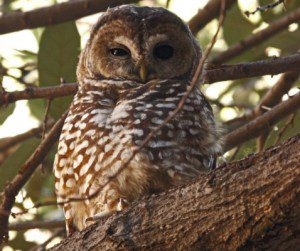
Oct 29, 2014 | Blog
FOR IMMEDIATE RELEASE
October 29, 2014
Contact: Courtney Sexton, csexton@defenders.org, 202-772-0253
Wendy Russell, wendy@patagoniaalliance.org, 520-477-2308
Groups file complaint against Forest Service and Fish and Wildlife Service for approval of mineral drilling project in Arizona’s Coronado National Forest
TUCSON, ARIZ. – Defenders of Wildlife and the Patagonia Area Resource Alliance today asked a federal court to hold the United States Forest Service and United States Fish and Wildlife Service accountable for their unlawful approval of the “Sunnyside” mineral exploration drilling project in southern Arizona’s Coronado National Forest, in the Alum Gulch area of the Patagonia Mountains. The groups say the approval of the Canadian mining company Regal Resources’ Sunnyside Project violates environmental laws and poses a potential threat to endangered species and the safety of drinking water for local residents. The Sunnyside Project involves drilling multiple exploratory holes up to 6,500 feet deep in one of the most biologically diverse mountain ranges in Arizona. The extensive drilling and construction would run 24/7 for months on end, and the total project operations could last up to 3 years.

Mexican spotted owl, ©Gooch Goodwin
The Coronado National Forest, the Patagonia Mountains and the watersheds in this region support some of the world’s most imperiled wildlife, including the jaguar, ocelot, lesser long-nosed bat, Mexican spotted owl, and yellow-billed cuckoo. Of particular concern is the Mexican spotted owl “Protected Activity Center” (PAC) in the Alum Gulch area, a site which is supposed to have the greatest protection of the law. One of the project’s proposed drilling sites is only one-tenth of a mile from the “nesting core area” of this PAC.
“The potential damage from the Sunnyside Project, especially coupled with other damaging mining projects in the region, could have devastating impacts on this imperiled wildlife and the habitat they depend on, as well as the water supply for local residents,” said Rob Peters of Defenders of Wildlife. “This is a national forest and imperiled wildlife and their habitats on the forest should be protected— not polluted by expanded drilling operations.”

Ocelot, Leopardus pardalis. photo US FWS
Patagonia area residents are dependent on water originating from Alum Gulch, an area which is also designated as critical habitat for the jaguar and Mexican spotted owl. The imperiled ocelot, lesser long-nosed bat, and yellow-billed cuckoo have also been observed near the project area.
“The Sunnyside Project could have tremendous adverse impacts on local wildlife and local residents, affecting the floodplains and the municipal watershed of the town of Patagonia,” said Wendy Russell of the Patagonia Area Resource Alliance. “The drilling will require 12,500 gallons of water per day, an amount approximately equal to ten percent of the daily water usage of the Town of Patagonia. This project threatens not only endangered wildlife, but our community’s water, health and safety.”
Click to hear from environmental attorneys on why they sue.
###
Defenders of Wildlife is dedicated to the protection of all native animals and plants in their natural communities. With more than 1.1 million members and activists, Defenders of Wildlife is a leading advocate for innovative solutions to safeguard our wildlife heritage for generations to come. For more information, visit www.defenders.org and follow us on Twitter @DefendersNews.
The Patagonia Area Resource Alliance is a citizen watchdog organization that monitors the activities of mining companies, as well as ensures government agencies’ due diligence, to make sure their actions have long-term, sustainable benefits to our public lands, our water, and the town of Patagonia. For more information visit www.patagoniaalliance.org and follow us on Twitter @PARAalliance.
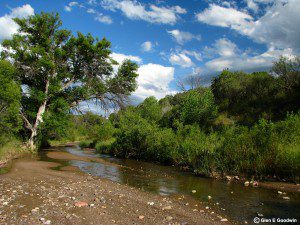
Oct 28, 2014 | Blog
Peer-reviewed report outlines Hermosa mine’s risks of water consumption, perpetual water pollution to Patagonia area
Patagonia Area Resource Alliance
Earthworks
October 28, 2014
 Patagonia – The Hermosa silver mine proposed inside Patagonia, Arizona’s Municipal Supply Watershed could deplete the town’s drinking water and perpetually contaminate area groundwater with acid mine drainage, according to a new peer-reviewed report.
Patagonia – The Hermosa silver mine proposed inside Patagonia, Arizona’s Municipal Supply Watershed could deplete the town’s drinking water and perpetually contaminate area groundwater with acid mine drainage, according to a new peer-reviewed report.
Reviewed* by a USGS scientist and released by the Patagonia Area Resource Alliance and Earthworks, the study also concludes that drinking water wells of surrounding residents are also threatened.
“A mine that threatens our town’s drinking water is a mine that shouldn’t be built,” said Wendy Russell of the Patagonia Area Resource Alliance. She continued, “In Arizona, water is more precious than silver, and especially so after more than a decade of drought.”
Proposed by Canadian exploration company AZ Mining Inc (Wildcat Silver) – a company with no experience operating a mine – Hermosa is proposed at a time when Patagonia is already concerned with dropping groundwater levels and increasing concern about future water supplies.
The 4,000 foot wide and 1,500 foot deep Hermosa silver and manganese mine would consume 670 million to 1.2 billion  gallons of groundwater per year – up to 53 times the amount of water the town uses today — to run the mine within the upper reaches of Harshaw Creek, a portion of Patagonia’s Municipal Supply Watershed. This water consumption will lower the recharge rates for the aquifer on which the town depends, and is also likely to produce acidic runoff, requiring ongoing treatment in perpetuity.
gallons of groundwater per year – up to 53 times the amount of water the town uses today — to run the mine within the upper reaches of Harshaw Creek, a portion of Patagonia’s Municipal Supply Watershed. This water consumption will lower the recharge rates for the aquifer on which the town depends, and is also likely to produce acidic runoff, requiring ongoing treatment in perpetuity.
“If the U.S. Forest Service were to permit the Hermosa mine, this report shows it would jeopardize our community’s drinking water. And for what? For foreign shareholders’ silver,” said Wendy Russell. She continued, “This is a mine proposal that just doesn’t make sense for our community who would actually have to live with it.”
The mine is proposed within the Coronado National Forest, and therefore subject to the 1872 Mining Law. Federal land managers interpret the 1872 Mining Law to require them to permit mines, no matter if the land is better used for other purposes – like protecting a town’s drinking water supply watershed.
“Because the Hermosa mine proposal threatens area water supplies, it obviously should not be permitted,” said report author Pete Dronkers of Earthworks. He continued, “That it’s being considered at all is a strong argument for reforming the 1872 Mining Law to allow the consideration of other potential land uses.”
The report also evaluates the nature of groundwater depletion that is likely under the proposed mine plan, characterizes the impacts of such, and also analyses other known adverse impacts, such as air pollution, endangered species, and other cumulative impacts.
The report, including an executive summary, can be found at: patagoniaalliance.org/report-hermosa-mine
For more information:
Fact Sheet
Full Report
Contact:
Pete Dronkers, Earthworks
(775) 815-9936, pdronkers@earthworksaction.org
Wendy Russell, Patagonia Area Resource Alliance
(520) 477-2308, wendy@patagoniaalliance.org
* An earlier version of this press release indicated that a USGS scientist “endorsed” this report. We were informed by the United States Geological Survey that the agency only endorses their own reports and documents.
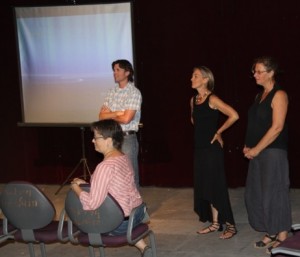
May 19, 2014 | Blog

Filmmaker Ben Johnson, Director Kimi Eisele and Composer Vicki Brown fielding questions.
The Patagonia Area Resource Alliance hosted a reception and screening of ‘Rosemont Ours’ in Patagonia on Saturday, May 17. The evening began with a reception at Molly’s Studio Patio followed by a screening of “Rosemont Ours,” a film of modern dance celebrating the plants and animals of the Santa Rita Mountains. Filmmaker Ben Johnson, Director Kimi Eisele and Composer Vicki Brown were on hand to introduce the film and answer questions. “Rosemont Ours” was born in response to the proposed construction of the Rosemont Mine. By “replacing” plants and animals with human beings in reverential and playful ways, the film invited us to consider our role as both stewards and consumers of nature. “Rosemont Ours” can be viewed online: http://rosemontours.com/the-video/
PARA board member, Carolyn Shafer also spoke to the audience providing an update to PARA’s activities, introducing the PARA board and thanking the community for their ongoing support. These are her words:
 The real wealth of a community is measured by its inhabitants – human, plant and animal. Our community is very wealthy. Our abundance is the water and air and land that has supported life in this region for many thousands of years. We all need to be involved in protecting our natural resources from further degradation and to regenerate our region’s habitat to better support our biodiversity. And that is the essence of Patagonia Area Resource Alliance’s mission statement.
The real wealth of a community is measured by its inhabitants – human, plant and animal. Our community is very wealthy. Our abundance is the water and air and land that has supported life in this region for many thousands of years. We all need to be involved in protecting our natural resources from further degradation and to regenerate our region’s habitat to better support our biodiversity. And that is the essence of Patagonia Area Resource Alliance’s mission statement.
Many of you here tonight help in this cause through your financial support which is deeply appreciated – some day we won’t have to ask for ongoing support but that day has not yet arrived. Some of us are able to give our time to this work and I’d like to introduce you to our Board and staff: Michael Stabile, Gooch Goodwin, Joe Nitche and not able to be here tonight: Cliff Hirsch, Kati Ballard, Lee Rogers. Our staff: Coordinator Wendy Russell and Social Media Outreach Colin Treiber.
In addition to help fund these efforts, writing comments is also appreciated including those recently submitted on the Wildcat Silver Hermosa drilling proposal. The next step will be the release by the Forest Service of the Final Environmental Assessment and the Draft Decision expected to be made public in June or July. That will open a 45 day Objection Period. If you commented on the Hermosa drilling proposal during a public comment period, you are eligible to participate in the objection process.
PARA is strategically creating alliances with other organizations. It is a gratifying experience to introduce representatives from these organizations to our corner of the cosmos. It is not an understatement to say that they fall in love with our area and value its unique biodiversity and want to assist in protecting the Patagonia Mountains.
-PARA coordinated a Coalition of International, Regional and Local Organizations to comment on the Forest Service Draft Environmental Assessment for the Hermosa drilling proposal. Those organizations are the Arizona Mining Reform Coalition, Center for Biological Diversity, Defenders of Wildlife, Earthworks, and Sky Island Alliance.
-We hosted the Defenders of Wildlife Southwest Office and legal team for a 2 day tour of proposed mine sites in the Patagonia Mountains.

WMAN conference participants from L: Roy Chavez, Concerned Citizens and Retire Miners Coalition; Wendy Russell, PARA; Aaron Mintzes, Earthworks; Lauren Pagel, Earthworks; and Roger Featherstone, AZ Mining Reform Coalition.
-Through a generous scholarship program, PARA Coordinator Wendy Russell attended the Western Mining Action Network (WMAN) conference on May 9-10, 2014 in Anchorage, Alaska. WMAN provides a critical forum for communities facing mining in the United States and Canada. Their conference provides an excellent venue for information sharing, networking, learning, and strategizing among organizations and individuals working to reduce the negative environmental and social impacts of mining.
-PARA has teamed with Earthworks to develop an independent, peer-reviewed study of the potential impacts of Wildcat Silver’s open pit mine on our groundwater, the potential for acid drainage contamination, heavy metals pollution, as well as the range of issues associated with air pollution, light and noise pollution.
Why do any of us give our time and our money for this cause? I think a quote from scientist David Suzuki summarizes the core motivation for each of us: “There are some things in the world we can’t change–gravity, entropy, the speed of light, and our biological nature that requires clean air, clean water, clean soil, clean energy and biodiversity for our health and well being. Protecting the biosphere should be our highest priority or else we sicken and die.”
Mar 27, 2014 | Blog
Tips for Writing Comments for a Draft EA
By Jenny Neeley
1. Consider whether the effects significant. If they are, then the Forest Service must prepare a more detailed Environmental Impact Statement (EIS) rather than an Environmental Assessment (EA). When deciding whether the impacts are “significant” NEPA implementing regulations (40 CFR § 1508.27) require that agencies consider both:
- Context: The significance of an action must be analyzed in several contexts such as society as a whole, the affected region, the affected interests, and the locality. Significance varies with the setting of the proposed action. For instance, in the case of a site-specific action, significance would usually depend upon the effects in the locale rather than in the world as a whole. Both short- and long-term effects are relevant.
- Intensity: This refers to the severity of impact. …The following should be considered in evaluating intensity:
- Impacts that may be both beneficial and adverse. A significant effect may exist even if the Federal agency believes that on balance the effect will be beneficial.
- The degree to which the proposed action affects public health or safety.
- Unique characteristics of the geographic area such as proximity to historic or cultural resources, park lands, prime farmlands, wetlands, wild and scenic rivers, or ecologically critical areas.
- The degree to which the effects on the quality of the human environment are likely to be highly controversial.
- The degree to which the possible effects on the human environment are highly uncertain or involve unique or unknown risks.
- The degree to which the action may establish a precedent for future actions with significant effects or represents a decision in principle about a future consideration.
- Whether the action is related to other actions with individually insignificant but cumulatively significant impacts. Significance exists if it is reasonable to anticipate a cumulatively significant impact on the environment. Significance cannot be avoided by terming an action temporary or by breaking it down into small component parts.
- The degree to which the action may adversely affect districts, sites, highways, structures, or objects listed in or eligible for listing in the National Register of Historic Places or may cause loss or destruction of significant scientific, cultural, or historical resources.
- The degree to which the action may adversely affect an endangered or threatened species or its habitat that has been determined to be critical under the Endangered Species Act of 1973.
- Whether the action threatens a violation of Federal, State, or local law or requirements imposed for the protection of the environment.
2. Make your comments “substantive” and specific. The Forest Service is required by law to respond to all “substantive” comments submitted during the public comment period; the more specific and focused your comments are, the more detailed the response must be from the agency. Comments that simply say “I am opposed to this project” will not, by themselves, require a response from the agency.
3. Include the specific sections, pages and/or topics you are referencing in the Draft EA. To the extent you can, direct your comments to specific sections, pages or topics in the Draft EA, recognizing that some comments may be addressing missing or incomplete information, or even missing topics, that you feel should be addressed.
4. Make your letter personal! Your personal connection to the Patagonia Mountains and surrounding area is an incredibly important part of your comment letter. You should explain how will you be personally impacted if this proposal moves forward. Include information about how it will affect your home, your land, your family, and/or your business and livelihood. This is a great way to start your letter and to frame the rest of your comments, and will help get the Forest Service’s attention.
Additional Information
See our NEPA Resources page: http://www.patagoniaalliance.org/nepa-resources/
More information about Wildcat Silver at: http://www.patagoniaalliance.org/wildcat-silver/
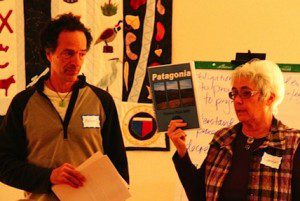
Dec 9, 2013 | Blog
It’s hard to believe that the end of the year is approaching! When 2013 began your friends, neighbors, and colleagues here at the Patagonia Area Resource Alliance (PARA) were gearing up for a busy year promoting the incredible beauty, community and natural heritage of your Town of Patagonia and the Patagonia Mountains. Little did we know what a whirlwind this year would be! The past eleven months have seemingly sped by while we have been advocating to protect this amazing place that we all treasure from the multiple threats that exploratory drilling and mining pose to our small community.
PARA was formed in 2011 to educate and engage the community about the risks and realities of mining, to promote local sustainable economies like ecotourism, to better understand our precious and imperiled natural resources such as clean water and wildlife, and to actively advocate for the protection of those resources in concert with Patagonia’s distinct and serene rural way of life.
You have helped us along the way this year! You have volunteered, come to public meetings, wrote letters to elected and appointed officials; you have taken a class to learn more about the wildlife in our midst and asked poignant questions about the future of our community. Together, we have contributed over 5000 volunteer hours already in 2013!
It has been an amazing and transforming year for PARA, but we have so much more to do! PARA runs on a shoestring budget with the human power of an almost entirely volunteer workforce and just one part-time, coordinator. We’d like to do so much more! Please consider making a donation to PARA this year to support and grow this critical work in our community.
We’d like to share with you just a few of the activities and milestones reached this year through the contributions of all of PARA’s supporters, volunteers and partners:

PARA Board members Michael & Carolyn
Educating the Community, Empowering Ourselves
With a grant awarded from Patagonia® Inc, PARA and Sky Island Alliance (SIA) co-hosted an Advocacy workshop for area residents with national expert Dinah Bear on the National Environmental Policy Act (NEPA). We put on two additional NEPA environmental impact scoping comment workshops on mining proposals and held four more letter writing sessions. The PARA Board also participated in our own workshops with SIA Executive Director, Melanie Emerson. Read more…
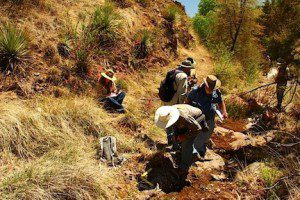
Dr. Van Devender & scientists in Harshaw Creek
Documenting Patagonia’s Natural History
We hosted a BioBlitz in the Patagonia Mountains with Dr. Tom Van Devender of SIA and scientists from all over the Southwest. 418 different species of plants and animals were documented in one weekend–including a new American record of the Willowleaf Oak (Quercus viminea). Results are being used to protect species and habitats imperiled by mining and drilling proposals and can be viewed online at www.madrean.org. Read more…
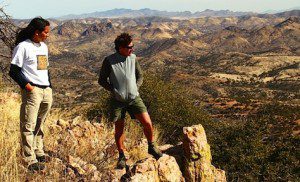
Sergio Avila and John Davis on American Peak
Advocating for Protection Through Tireless Outreach
PARA steadfastly engages elected officials and national organizations regarding the perils that Patagonia faces with proposed mining. This year we conducted tours of proposed mine sites to representatives from the U.S. Senate, Defenders of Wildlife, EARTHWORKS, TrekWest and the media. We remain dogged in our outreach to get and keep attention focused here. Read more…
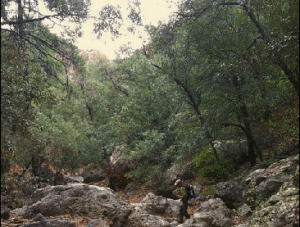
Board member Gooch hiking in Humboldt Canyon
Ensuring Agencies’ Due Diligence
We successfully made the case that the NEPA scoping period for Regal Resources mineral drilling proposal in Humboldt Canyon be re-opened. PARA advocated and reasoned with the District Ranger of the US Forest Service that NEPA decisions should be made using current rather than outdated information. He concurred and ultimately gave us all two additional years to prepare data for more comprehensive scoping comments that can accurately articulate the broadest range of potential impacts. Read more…
To learn more about our 2013 accomplishments and efforts, please take a look at PARA’s “Report to the Community” available on our website at: www.patagoniaalliance.org/our-activities-outreach/
Looking Ahead…
Unceasing Protection of the Patagonia Mountains.
With continued legal assistance from Defenders of Wildlife, PARA strives to hold mining companies, the US Forest Service and all agencies accountable to follow the laws and regulations designed to protect our water, air, surrounding ecosystems and communities. We are positioned to respond to future public scoping notices for exploratory mining proposals scheduled for the Patagonia Mountains.
Sustaining Wildlife Data Documentation and Collaborations
Citizen scientists from the Town of Patagonia continue wildlife monitoring efforts in the Patagonia Mountains focusing on areas immediately at risk by proposed mining activities. Data gathered is used to fight mining proposals through species lists, presence of vulnerable species and habitat analysis. Additional collaborations are ongoing with Defenders of Wildlife, EARTHWORKS, Sky Island Alliance and others to ensure this data is applied to advocacy efforts in the most effective ways.
Increasing Our Outreach for 2014
PARA is strategizing to expand community education activities to grow our base of support and empower concerned residents with potential actions to keep mining out of the Patagonia Mountains. We recognize the need to establish sustainable funding to maintain core functions and seek to expand funding sources. Receiving our own 501(c)(3) non-profit status was just the first step. With additional staff funding in the 2014 budget, we plan to add members to our team to continue to expand our outreach beyond our community boundaries. Our 2013 Financial Report is also available online: www.patagoniaalliance.org/our-activities-outreach/
For A Thriving Community in 2014 and beyond
PARA recognizes that the health and economic prosperity of our community are deeply connected to the wellbeing of the Patagonia Mountains and the Harshaw/Sonoita Creek watershed. They are the source of our drinking water, clean air and the centerpiece for the tourism that drives our local economy.
Please make a Year-End Gift to PARA
There are many needs in our community and many compelling requests for support. We believe one of the most fundamental is protecting our drinking water and our community from the well-known detrimental effects of open pit mining. To that end, PARA is seeking to raise $19,000 by the end of 2013 to support the several ongoing and new initiatives outlined above as we move into 2014. We are fortunate to have a group of amazingly committed community members and generous donors supporting our work, but we are looking to broaden the base of support to ensure not only financial sustainability, but also the ability to impact local, regional and national decision-making on our own behalf. That’s where you come in. The work necessary to make this vision of 2014 a reality is possible only because of your time and your financial support. Please make a gift today.
Please donate to PARA securely online at: www.patagoniaalliance.org/donations/
Every single contribution makes a sizable difference to our organization and ultimately for our community. It is only because of the generous support from people like you that we can undertake this critical work. Thank you!
Your PARA Board and Coordinator
Carolyn Shafer, Cliff Hirsch, Gooch Goodwin, Joseph Nitsche, Katie Flemming-Ballard, Lee Rogers, Michael Stabile and Wendy Russell
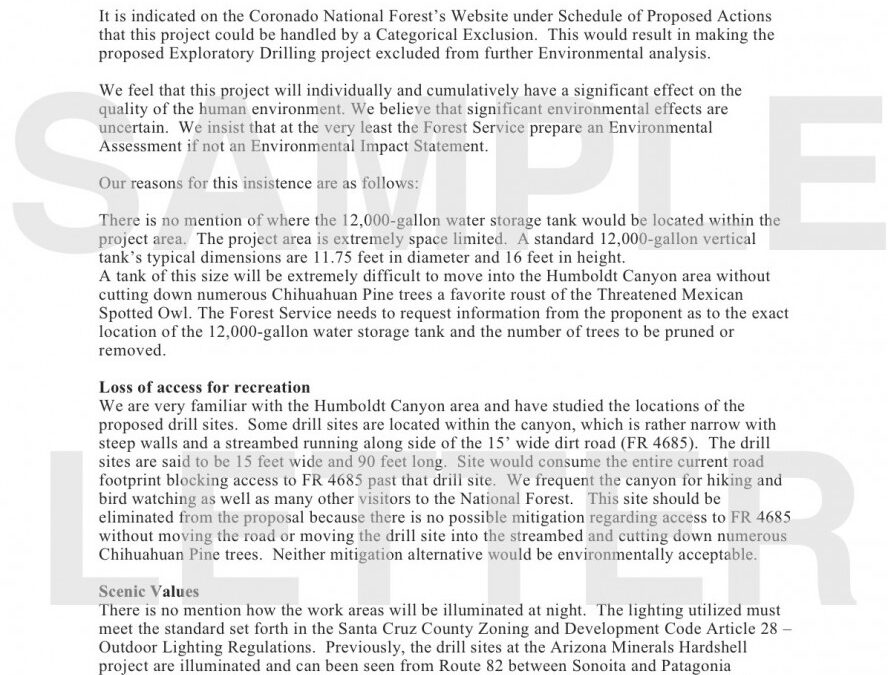
Aug 9, 2013 | Blog
By Jenny Neeley, Conservation Policy Director & Legal Counsel of Sky Island Alliance
Introduction
The National Environmental Policy Act (NEPA) requires federal agencies to go through a public “scoping process” in order to determining the scope of issues to be addressed in an environmental assessment (EA) or environmental impact statement (EIS). To start the process, the agency must issue a Notice of Intent and invite public input on the scope of issues to be examined. The US Forest Service is required to go through a public scoping process for all proposed actions, including those that the Forest proposes to categorically exclude from NEPA analysis.
When agencies give proposed projects a “categorical exclusion” from NEPA, the agency is not required to take a close look at the environmental impacts of the project. Below is more information on how the public can engage in the scoping process and make the case that the project should not be categorically excluded, but should instead be subject to an EA or an EIS under NEPA.
What is a Categorical Exclusion?
A categorical exclusion (referred to as ‘CE’ or ‘Cat Ex’) is a category of actions established by each individual agency that are exempted from the NEPA requirements to prepare an EA or EIS because they are considered to not have a significant effect on the human environment, either individually or cumulatively.¹ A proposed action may be categorically excluded from preparing an EIS or EA only if it fits into one of these categories and “if there are no extraordinary circumstances related to the proposed action.”
Challenging Categorical Exclusions in Scoping Comments
There are four steps to writing effective comments that challenge the use of categorical exclusions:
1. Check the mining plan to make sure the proposed action fits into the categorical exclusion for mineral exploration activities: “Short-term (1 year or less) mineral, energy, or geophysical investigations and their incidental support activities that may require cross-country travel by vehicles and equipment, construction of less than 1 mile of low standard road, or use and minor repair of existing roads.”² If the proposed action does not meet these parameters, then it cannot be excluded from NEPA.
2. Determine whether there are any “extraordinary circumstances” that relate to this proposed action: Resource conditions that are considered in determining whether extraordinary circumstances exist are:
- Federally listed threatened or endangered species or designated critical habitat, species proposed for Federal listing or proposed critical habitat, or Forest Service sensitive species; View list for Patagonia Mountain area.
- Flood plains, wetlands, or municipal watersheds;
- Congressionally designated areas, such as wilderness, wilderness study areas, or national recreation areas;
- Inventoried roadless areas or potential wilderness areas;
- Research natural areas;
- American Indians and Alaska Native religious or cultural sites, and
- Archaeological sites, or historic properties or areas.³
3. If one or more of the above resource conditions exist in the project area, you must demonstrate that:
- There is a cause-and-effect relationship between a proposed action and the potential effect on the resource conditions considered “extraordinary circumstances,” and
- The degree of potential effect on those resources – including cumulative effects – raises uncertainty over whether those effects are significant. If you can raise this uncertainty about the significance of potential impacts, you can make a good case for precluding the use of a categorical exclusion.
4. Show that the impacts of all past, present, and reasonably foreseeable future actions in the project area raise uncertainty about the significance of the “cumulative impacts” of this project. The Forest is required to examine the impacts of all past, present, and reasonably foreseeable future actions in the project area, regardless of what agency or entity is undertaking those actions, and determine the potential for cumulative impacts. When a project is proposed to receive a cat ex, you can make the case for preparing an EA by raising uncertainty over the significance of these effects.
Asking for an EA and Identifying Scope of Issues
After making the case that a categorical exclusion is inappropriate, don’t forget to also identify the scope of issues you think should be addressed in the EA you are asking the agency to prepare. It is important submit comments identifying the full range of resources and issues that may be impacted by the proposed action. These resources and issues generally include:
- Water quality
- Water quantity
- Air quality
- Soils
- Vegetation and wildlife
- Threatened and endangered species
- Wildlife corridors/wildlife movement
- Cultural resources
- Visual resources and scenic values
- Dark Skies
- Recreation
- Public safety
- Transportation
- Socioeconomic Impacts
- Cumulative Impacts
Remember: you don’t have to do the analysis for them. At the scoping stage, you just need to identify the issues they must analyze. You should also submit any research or supporting documentation that is relevant to assessing the impacts of this project on the identified resources. The agency is obligated to consider this material in its assessment.
Other online resources:
PARA NEPA Resources page
USFS NEPA Handbook: Categorical Exclusions
Citizen’s Guide to NEPA
Challenging Categorical Exclusions in Scoping Comments: Letter Template
[Date]
[Address]
[Re: Project name]
Open your letter with something personal describing why you care about this place: “I am a resident of Patagonia;” “I often visit the Patagonia Mountains for recreation/employment/tourism;” “I own a property in the area;” etc.
This project should not qualify for a categorical exclusion from NEPA. a) Extraordinary circumstances in the project area raise uncertainty about the project’s impacts; and b) The potential for cumulative impacts raise uncertainty about the project’s impacts. (See above for more information on how to make this argument effectively.)
The agency [Forest Service] should prepare an environmental assessment to analyze the impacts of this project on all the resources in the project area. (See above for sample list of resources and issues to identify.)
August 15, 2013 public comment deadline for Regal Resources Sunnyside mining exploration proposal.
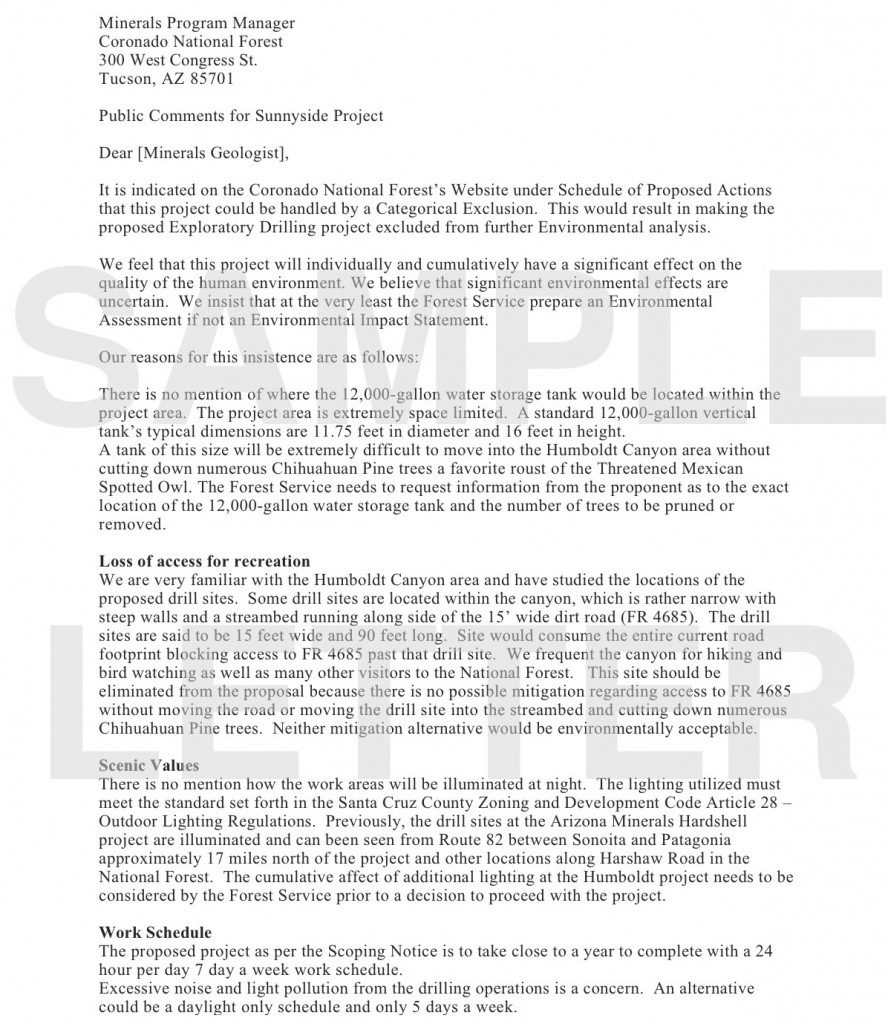
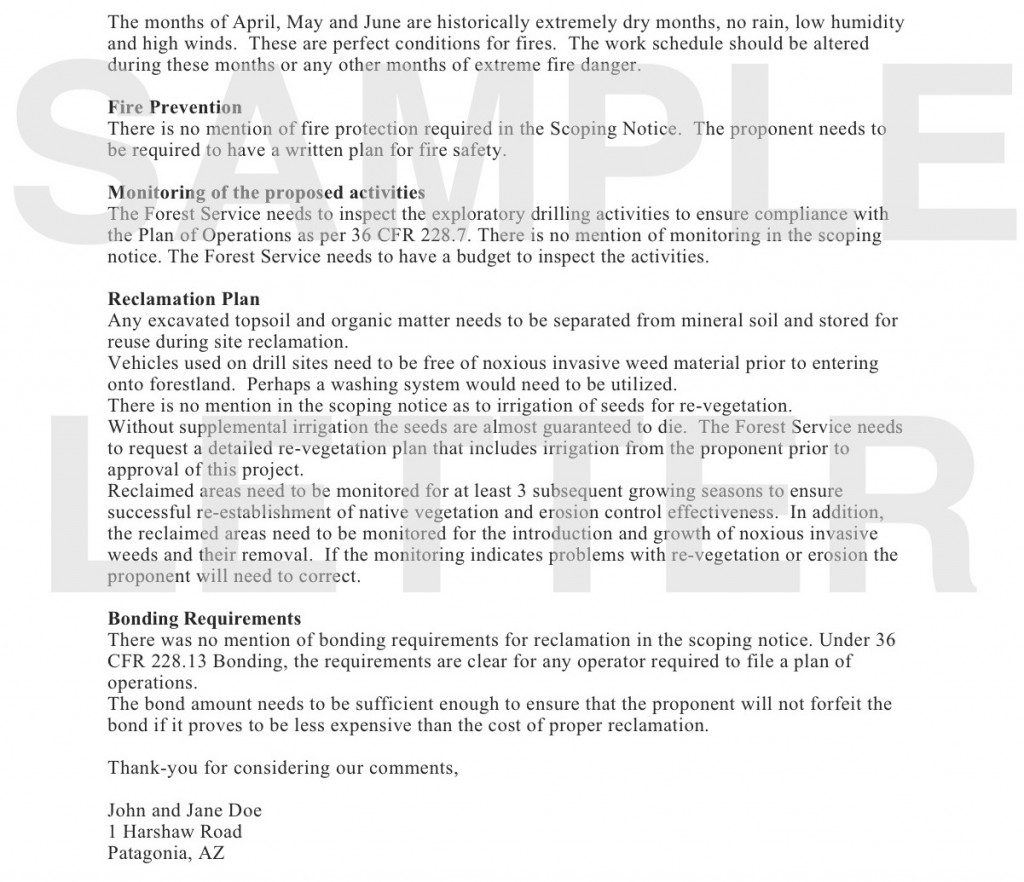
———————-
1. Council for Environmental Quality (CEQ) Regulations for Implementing the National Environmental Policy Act (40 CFR 1508.4). Available at nepa.gov/ceq_regulations/regulations.html
2. USFS NEPA Handbook; FSH 1909.15; 36 CFR 220.6(e)(8)). Available online at http://www.patagoniaalliance.org/wp-content/uploads/2013/08/US-Forest-Service-NEPA-Handbook_Categorical-Exclusion-regs.pdf
3. USFS NEPA Handbook, FSH 1909.15; 36 CFR 220.6(b). Available online at http://www.patagoniaalliance.org/wp-content/uploads/2013/08/US-Forest-Service-NEPA-Handbook_Categorical-Exclusion-regs.pdf









 Rob Peters, Senior Representative, Southwest Office
Rob Peters, Senior Representative, Southwest Office



 Test results showed off-the-chart concentrations of lead and arsenic in water, soil and waste rock samples at the Lead Queen site. High concentrations of zinc, copper and aluminum were also found. All of these heavy metals are listed as “hazardous substances” and can cause serious – or even deadly – health issues. The red-orange color of the sludge was due to extreme concentrations of iron.
Test results showed off-the-chart concentrations of lead and arsenic in water, soil and waste rock samples at the Lead Queen site. High concentrations of zinc, copper and aluminum were also found. All of these heavy metals are listed as “hazardous substances” and can cause serious – or even deadly – health issues. The red-orange color of the sludge was due to extreme concentrations of iron. The Forest Service document also acknowledges that the “Patagonia Mountains have high levels of biodiversity and are home to a variety of species protected under the Endangered Species Act including jaguar, ocelot, lesser long-nosed bat, Mexican spotted owl, western yellow-billed cuckoo, Sonora tiger salamander, and the northern Mexican gartersnake.”
The Forest Service document also acknowledges that the “Patagonia Mountains have high levels of biodiversity and are home to a variety of species protected under the Endangered Species Act including jaguar, ocelot, lesser long-nosed bat, Mexican spotted owl, western yellow-billed cuckoo, Sonora tiger salamander, and the northern Mexican gartersnake.”








 Patagonia – The Hermosa silver mine proposed inside Patagonia, Arizona’s Municipal Supply Watershed could deplete the town’s drinking water and perpetually contaminate area groundwater with acid mine drainage, according to a new peer-reviewed report.
Patagonia – The Hermosa silver mine proposed inside Patagonia, Arizona’s Municipal Supply Watershed could deplete the town’s drinking water and perpetually contaminate area groundwater with acid mine drainage, according to a new peer-reviewed report.

 The real wealth of a community is measured by its inhabitants – human, plant and animal. Our community is very wealthy. Our abundance is the water and air and land that has supported life in this region for many thousands of years. We all need to be involved in protecting our natural resources from further degradation and to regenerate our region’s habitat to better support our biodiversity. And that is the essence of Patagonia Area Resource Alliance’s mission statement.
The real wealth of a community is measured by its inhabitants – human, plant and animal. Our community is very wealthy. Our abundance is the water and air and land that has supported life in this region for many thousands of years. We all need to be involved in protecting our natural resources from further degradation and to regenerate our region’s habitat to better support our biodiversity. And that is the essence of Patagonia Area Resource Alliance’s mission statement. 








